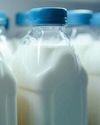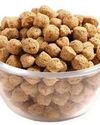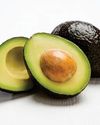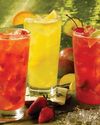
What are microfibers?
These man-made materials are highly popular and usually chosen by the fashion industry because of their availability, durability, resistance, and affordability. When manufactured, washed, and worn, synthetic clothes & textiles shed tiny plastic fibers that end up in the environment. Plastic that ends up in the environment does not biodegrade: it fragmentizes into smaller pieces. These tiny pieces, called microfibers, are smaller than 5 mm and usually not visible to the naked eye.
Microfiber pollution through washing & wearing
Plastic particles washed off from products such as synthetic clothes & textiles contribute to 35% of primary microplastics polluting our oceans, according to a report by the International Union for Conservation of Nature (IUCN). Primary microplastics are directly released into the environment as small plastic particles (< 5 mm size). On the contrary, secondary microplastics are not directly released. into the environment, but they originate from the degradation of large plastic into smaller plastic fragments. Every time we do our laundry, an average of 9 million microfibers are released into wastewater treatment plants, which cannot retrieve them and end up in the ocean. Also, plastic fibers are constantly released into the air just by wearing synthetic clothes. Research studies have proven that we are eating and drinking plastic and that plastic fibers are even raining down from the sky. We are breathing in at least 13,000 to 68,000 plastic microfibers from our clothing, carpets, curtains, and other textiles per year. This ubiquitous microfiber pollution's consequences seem disastrous to animals and humans.
Recent News on Microfiber Contamination
This story is from the {{IssueName}} edition of {{MagazineName}}.
Start your 7-day Magzter GOLD free trial to access thousands of curated premium stories, and 9,000+ magazines and newspapers.
Already a subscriber ? Sign In
This story is from the {{IssueName}} edition of {{MagazineName}}.
Start your 7-day Magzter GOLD free trial to access thousands of curated premium stories, and 9,000+ magazines and newspapers.
Already a subscriber? Sign In

Therapeutic Use Of Indian Winter Cherry (Ashwagandha)
Ashwagandha is one of the most important herbs in Ayurveda, which is a traditional form of alternative medicine based on Indian principles of natural healing. Ashwagandha is a small, woody shrub in the Solanaceae family that grows about two feet in height.

The Dairy Chain Revolution: Ensuring Freshness and Efficiency
Dairy products are an integral part of the food processing industry, forming milk, cheese, yogurt, and butter are highly perishable and demand meticulous care to preserve their quality and safety throughout their journey from farm to consumer.

Plant-Based Proteins from Soybean: A Comprehensive Exploration
Introduction - In recent years, the global food landscape has witnessed a remarkable shift toward plant-based diets, driven by a growing awareness of health, environmental sustainability, and ethical considerations.

Avocado: The Green Ally in the Fight Against Diabetes
In a world inundated with processed foods laden with excessive sugars, salts, and artificial additives, rates of diabetes across the world have been rising over the past decades link.

Inspection Technology from KHS: Precision and early detection for holistic line thinking
KHS GmbH continuously develops and modernizes its inspection technology.

Packaging for the Future: How Aseptic Solutions are Transforming the Dairy Industry
Introduction - The Dairy Aseptic Packaging Market T is a dynamic and transformative sector within the rapidly evolving food and beverage industry.

Sidel introduces its breakthrough bottle washer with powerful dual technology - Hydra Ultrasonic
With beverage bottlers requiring a solution that reduces production costs while improving their environmental footprint, Sidel has launched its new bottle washer which combines chemical and ultrasound technology for the highest performance. Sidel will unveil Hydra Ultrasonic for the first time at the international trade show, BrauBeviale.

Revolutionizing Dairy Packaging: Technology & Innovations Shaping the Future
Dairy packaging plays a vital role in maintaining the quality and safety of a wide variety of products, including milk, butter, cheese, and yogurt.

Proost: Brewing Passion, Driving Innovation, Redefining Quality
In an exclusive conversation Mr. Tarun Bhargava, Co-Founder & CEO of Proost, speaks about the brand's inspiring journey, its unique approach to brewing, and the innovative strategies driving its success. From Proost's commitment to quality and sustainability to its adaptability in a dynamic market, Tarun shares insights into what makes Proost a standout in the beverage industry.

Non-Alcoholic Beverages: A Booming Industry Across Global Markets
The global non-alcoholic beverage market has been expanding steadily, with an estimated value of over USD 1 trillion as of 2023. This growth is expected to continue, fueled by a shift in consumer preferences toward healthier and more mindful consumption habits. The market encompasses a variety of products, including non-alcoholic beers, soft drinks, juices, and functional beverages like energy drinks and flavored waters.